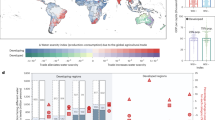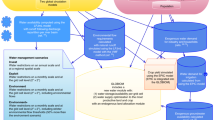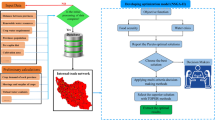Abstract
With a rapidly growing population of 250 million, the Indus river basin in South Asia is one of the most intensively cultivated regions on Earth, highly water stressed and lacking energy security. Yet, most studies advising sustainable development policy have lacked multi-sectoral and cross-country perspectives. Here we show how the countries in the Indus basin could lower costs for development and reduce soil pollution and water stress by cooperating on water resources and electricity and food production. According to this analysis, Indus basin countries need to increase investments to US$10 billion per yr to mitigate water scarcity issues and ensure improved access to resources by 2050. These costs could shrink to US$2 billion per yr, with economic gains for all, if countries pursued more collaborative policies. Downstream regions would benefit most, with reduced food and energy costs and improved water access, while upstream regions would benefit from new energy investments. Using integrated water–energy–land analysis, this study quantifies the potential benefits of novel avenues to sustainable development arising from greater international cooperation.
This is a preview of subscription content, access via your institution
Access options
Access Nature and 54 other Nature Portfolio journals
Get Nature+, our best-value online-access subscription
$29.99 / 30 days
cancel any time
Subscribe to this journal
Receive 12 digital issues and online access to articles
$119.00 per year
only $9.92 per issue
Buy this article
- Purchase on Springer Link
- Instant access to full article PDF
Prices may be subject to local taxes which are calculated during checkout




Similar content being viewed by others
Data availability
Processed input data used for model runs that support the findings of this study, and associated model code, are publicly available (in the .RData format) at https://github.com/iiasa/NEST. Availability of raw data is in some cases subject to third-party restrictions. The data are however available from the corresponding author upon request, subject to permission, when this applies.
Code availability
Model code updated to the scenarios described in this publication is also available for download at https://doi.org/10.5281/zenodo.4037884.
References
Laghari, A. N., Vanham, D. & Rauch, W. The Indus basin in the framework of current and future water resources management. Hydrol. Earth Syst. Sci. 16, 1063–1083 (2012).
Wada, Y. et al. Co-designing Indus water–energy–land futures. One Earth 1, 185–194 (2019).
AQUASTAT Transboundary River Basin Overview—Indus (FAO, 2011); https://go.nature.com/2KxKRqB
Aslam, M. Agricultural productivity current scenario, constraints and future prospects in Pakistan. Sarhad J. Agric. 32, 289–303 (2016).
Karimi, P., Bastiaanssen, W. G. M., Molden, D. & Cheema, M. J. M. Basin-wide water accounting based on remote sensing data: an application for the Indus basin. Hydrol. Earth Syst. Sci. 17, 2473–2486 (2013).
Akhter, M. in Imagining Industan—Overcoming Water Insecurity in the Indus Basin (eds Adeel, Z. & Wirsing, R. G.) 21–33 (Springer, 2017); https://go.nature.com/3pVNgvo
Yu, W. et al. Indus Basin of Pakistan: Impacts of Climate Risks on Water and Agriculture (World Bank, 2013); https://go.nature.com/3kY7dxV
Cheema, M., Immerzeel, W. & Bastiaanssen, W. Spatial quantification of groundwater abstraction in the irrigated Indus Basin. Groundwater 52, 25–36 (2014).
Syvitski, J. P. et al. Anthropocene metamorphosis of the Indus Delta and lower floodplain. Anthropocene 3, 24–35 (2013).
Adeel, Z. & Wirsing, R. G. in Imagining Industan—Overcoming Water Insecurity in the Indus Basin (eds Adeel, Z. & Wirsing, R. G.) 3–20 (Springer, 2017); https://go.nature.com/3pYJHF1
Raman, D. Damming and infrastructural development of the Indus River basin: strengthening the provisions of the indus waters treaty. Asian J. Int. Law 8, 372–402 (2018).
Archer, D. R., Forsythe, N., Fowler, H. J. & Shah, S. M. Sustainability of water resources management in the Indus Basin under changing climatic and socio economic conditions. Hydrol. Earth Syst. Sci. 14, 1669–1680 (2010).
Just, R. E. & Netanyahu, S. Conflict and Cooperation on Trans-Boundary Water Resources (Springer, 1998).
Qamar, M. U., Azmat, M. & Claps, P. Pitfalls in transboundary Indus Water Treaty: a perspective to prevent unattended threats to the global security. npj Clean Water 2, 22 (2019).
Grill, G. et al. Mapping the world’s free-flowing rivers. Nature 569, 215–221 (2019).
Wu, X. & Whittington, D. Incentive compatibility and conflict resolution in international river basins: a case study of the Nile Basin. Water Resour. Res. 42, W02417 (2006).
Keskinen, M. et al. The water–energy–food nexus and the transboundary context: insights from large Asian rivers. Water 8, 193 (2016).
Bhaduri, A. et al. Achieving Sustainable Development Goals from a water perspective. Front. Environ. Sci. 4, 64 (2016).
Howells, M. et al. Integrated analysis of climate change, land-use, energy and water strategies. Nat. Clim. Change 3, 621–626 (2013).
Liu, J. et al. Nexus approaches to global sustainable development. Nat. Sustain. 1, 466–476 (2018).
Bleischwitz, R. et al. Resource nexus perspectives towards the United Nations Sustainable Development Goals. Nat. Sustain. 1, 737–743 (2018).
Albrecht, T. R., Crootof, A. & Scott, C. A. The water–energy–food nexus: a systematic review of methods for Nexus assessment. Environ. Res. Lett. 13, 043002 (2018).
Kaddoura, S. & El Khatib, S. Review of water–energy–food nexus tools to improve the nexus modelling approach for integrated policy making. Environ. Sci. Policy 77, 114–121 (2017).
Siddiqi, A. & Wescoat, J. L. Energy use in large-scale irrigated agriculture in the Punjab province of Pakistan. Water Int. 38, 571–586 (2013).
Stewart, J. et al. Indus River System Model (IRSM)—a Planning Tool to Explore Water Management Options in Pakistan: Model Conceptualisation, Configuration and Calibration (CSIRO Land & Water, 2018); https://go.nature.com/3q4rkyz
Yang, Y. C. E., Ringler, C., Brown, C. & Mondal, M. A. H. Modeling the agricultural water–energy–food nexus in the Indus River basin, Pakistan. J. Water Resour. Plan. Manag. 142, 04016062 (2016).
de Strasser, L., Lipponen, A., Howells, M., Stec, S. & Bréthaut, C. A methodology to assess the water energy food ecosystems nexus in transboundary river basins. Water 8, 59 (2016).
Parrachino, I., Dinar, A. & Patrone, F. Cooperative Game Theory and its Application to Natural, Environmental, and Water Resource Issues: 3. Application to Water Resources Policy Research Working Papers (World Bank, 2006); https://go.nature.com/2UXhPCQ
Singh, A., Jamasb, T., Nepal, R. & Toman, M. A. Cross-Border Electricity Cooperation in South Asia Policy Research Working Paper No. 7328 (World Bank, 2015).
Hasson, R., Löfgren, Å. & Visser, M. Climate change in a public goods game: investment decision in mitigation versus adaptation. Ecol. Econ. 70, 331–338 (2010).
Dalin, C., Wada, Y., Kastner, T. & Puma, M. J. Groundwater depletion embedded in international food trade. Nature 543, 700–704 (2017).
Kalair, A. R. et al. Water, energy and food nexus of Indus Water Treaty: water governance. Water-Energy Nexus 2, 10–24 (2019).
Vinca, A. et al. The NExus Solutions Tool (NEST) v1.0: an open platform for optimizing multi-scale energy-water-land system transformations. Geosci. Model Dev. 13, 1095–1121 (2020).
Mir, K. A., Purohit, P. & Mehmood, S. Sectoral assessment of greenhouse gas emissions in Pakistan. Environ. Sci. Pollut. Res. 24, 27345–27355 (2017).
Ahmad, B. & Saqlain, S. People perception regarding possible impact of urbanization on environmental degradation in Islamabad. IAU Int. J. Soc. Sci. 8, 1–10 (2018).
Scott, C. A., Vicuña, S., Blanco-Gutiérrez, I., Meza, F. & Varela-Ortega, C. Irrigation efficiency and water-policy implications for river basin resilience. Hydrol. Earth Syst. Sci. 18, 1339–1348 (2014).
Grafton, R. Q. et al. The paradox of irrigation efficiency. Science 361, 748–750 (2018).
Baum, R., Luh, J. & Bartram, J. Sanitation: A global estimate of sewerage connections without treatment and the resulting impact on MDG progress. Environ. Sci. Technol. 47, 1994–2000 (2013).
González-villareal, F. & Schultz, B. Final Report of IPOE for Review of Studies on Water Escapages Below Kotri Barrage Technical Report (ResearchGate, 2018); https://doi.org/10.13140/RG.2.2.28670.02885
Casillas, C. E. & Kammen, D. M. The energy–poverty–climate nexus. Science 26, 1181–1182 (2010).
GDP (current US$)—Pakistan (World Bank, 2020); https://go.nature.com/2KCSDzB
Singh, A., Jamasb, T., Nepal, R. & Toman, M. Electricity cooperation in South Asia: barriers to cross-border trade. Energy Policy 120, 741–748 (2018).
Rasul, G., Neupane, N., Hussain, A. & Pasakhala, B. Beyond hydropower: towards an integrated solution for water, energy and food security in South Asia. Int. J. Water Resour. Dev. https://doi.org/10.1080/07900627.2019.1579705 (2019).
Lutz, A. F., Immerzeel, W. W., Kraaijenbrink, P. D., Shrestha, A. B. & Bierkens, M. F. Climate change impacts on the upper Indus hydrology: sources, shifts and extremes. PLoS ONE 11, e0165630 (2016).
Maurer, J. M., Schaefer, J. M., Rupper, S. & Corley, A. Acceleration of ice loss across the Himalayas over the past 40 years. Sci. Adv. 5, eaav7266 (2019).
Immerzeel, W. W., Van Beek, L. P. & Bierkens, M. F. Climate change will affect the Asian water towers. Science 328, 1382–1385 (2010).
Biemans, H. et al. Importance of snow and glacier meltwater for agriculture on the Indo-Gangetic Plain. Nat. Sustain. 2, 594–601 (2019).
Majhi, B. & Kumar, A. Changing cropping pattern in Indian agriculture. J. Econ. Soc. Dev. 14, 37–45 (2018).
Burek, P. et al. Development of the Community Water Model (CWatM v1.04)—a high-resolution hydrological model for global and regional assessment of integrated water resources management. Geosci. Model Dev. 13, 3267–3298 (2020).
Huppmann, D. et al. The MESSAGEix Integrated Assessment Model and the ix modeling platform (ixmp): an open framework for integrated and cross-cutting analysis of energy, climate, the environment, and sustainable development. Environ. Model. Softw. 112, 143–156 (2019).
Messner, S. & Strubegger, M. User’s Guide for MESSAGE III IIASA Working Paper (IIASA, 1995).
Riahi, K., Grübler, A. & Nakicenovic, N. Scenarios of long-term socio-economic and environmental development under climate stabilization. Technol. Forecast. Soc. Change 74, 887–935 (2007).
Van Vliet, O. et al. Synergies in the Asian energy system: climate change, energy security, energy access and air pollution. Energy Econ. 34, S470–S480 (2012).
Kiani, B. et al. Optimal electricity system planning in a large hydro jurisdiction: will British Columbia soon become a major importer of electricity? Energy Policy 54, 311–319 (2013).
Salmivaara, A. et al. Exploring the modifiable areal unit problem in spatial water assessments: a case of water shortage in monsoon Asia. Water 7, 898–917 (2015).
Yang, Y.-C. E., Brown, C. M., Yu, W. H. & Savitsky, A. An introduction to the IBMR, a hydro-economic model for climate change impact assessment in Pakistan’s Indus River basin. Water Int. 38, 632–650 (2013).
Kahil, T. et al. A continental-scale hydroeconomic model for integrating water-energy-land nexus solutions. Water Resour. Res 54, 7511–7533 (2018).
Kim, S. H. et al. Balancing global water availability and use at basin scale in an integrated assessment model. Clim. Change 136, 217–231 (2016).
Payet-Burin, R., Kromann, M., Pereira-Cardenal, S., Strzepek, K. M. & Bauer-Gottwein, P. WHAT-IF: an open-source decision support tool for water infrastructure investment planning within the water–energy–food-climate nexus. Hydrol. Earth Syst. Sci. 23, 4129–4152 (2019).
Sridharan, V., Shivakumar, A., Niet, T., Ramos, E. P. & Howells, M. Land, energy and water resource management and its impact on GHG emissions, electricity supply and food production- Insights from a Ugandan case study. Environ. Res. Commun. 2, 085003 (2020).
Saif, Y. & Almansoori, A. An optimization framework for the climate, land, energy, and water (CLEWS) nexus by a discrete optimization model. Energy Procedia 105, 3232–3238 (2017).
Smakhtin, V. U., Revenga, C. & Doll, P. Taking Into Account Environmental Water Requirements in Global-scale Water Resources Assessments IWMI Research Reports (IWMI, 2004).
Van Vuuren, D. P. et al. The representative concentration pathways: an overview. Clim. Change 109, 5 (2011).
O’Neill, B. C. et al. The roads ahead: narratives for shared socioeconomic pathways describing world futures in the 21st century. Glob. Environ. Change 42, 169–180 (2017).
Acknowledgements
We acknowledge the Global Environment Facility (GEF) for funding the development of this research as part of the Integrated Solutions for Water, Energy, and Land (ISWEL) project (GEF Contract Agreement: 6993), and the support of the United Nations Industrial Development Organization (UNIDO). This research has also been supported by the University of Victoria’s Building Connections internal grant and the Natural Sciences and Engineering Research Council of Canada. We thank A. Hillers, R. Novak, D. Grey, L. Srivastava and Y. Sokona, members of the ISWEL steering committee, for the enthusiasm and support that characterized the whole collaboration.
Author information
Authors and Affiliations
Contributions
A.V., S.P., A.S., A.M., A.I., P.M. and K.R. conceived of the research questions and scenario design. A.S., A.M., A.I., B.W., N.Y. and M.A. helped enrich the regional background of the research. A.V. and S.P. led model development. A.V. led the analysis of results, the preparation of figures, data tables and online repositories, and the writing of the manuscript. All the authors contributed to reviewing the manuscript.
Corresponding author
Ethics declarations
Competing interests
The authors declare no competing interests.
Additional information
Peer review information Nature Sustainability thanks Neal Graham, Joseph Guillaume and Mark Howells for their contribution to the peer review of this work.
Publisher’s note Springer Nature remains neutral with regard to jurisdictional claims in published maps and institutional affiliations.
Extended data
Extended Data Fig. 1 Population and GDP projections.
Population trend and GDP per capita in the Indus basin, from 2010 to 2060.
Extended Data Fig. 2 Exogenous demands.
Exogenous agriculture products (a) electricity (b) and water (c) demands. For each country and the whole Indus basin, from 2010 to 2050. Endogenous cross sectoral demands (that is water for agriculture, energy far water management) depend on the scenario considered.
Extended Data Fig. 3 Sectoral cost differences.
Total cost changes between SDG-coop and BAU (a) and between0020SDG-coop and SDG (b) scenario by country, changes refer to areas within the basin boundary.
Extended Data Fig. 4 Country socio-environmental benefits.
Sectorial socio-environmental benefits of SDG and SDG-coop scenarios with respect to BAU in 2050. indicators: Cumulative air pollutants’ emissions from electricity generation and land use (SO2, CO, NH3, VOC); cumulative CO2 equivalent emitted; average surface and groundwater use per unit of crop product; cumulative release of pollutants from fertilizers (K2O, N, N2O, P2O5, VOC); number of people with not access to sanitation and clean water; difference between lowest and highest discharge river level across scenarios.
Supplementary information
Supplementary Information
Supplementary Figs. 1–5, Tables 1–7, Discussion and Methods.
Rights and permissions
About this article
Cite this article
Vinca, A., Parkinson, S., Riahi, K. et al. Transboundary cooperation a potential route to sustainable development in the Indus basin. Nat Sustain 4, 331–339 (2021). https://doi.org/10.1038/s41893-020-00654-7
Received:
Accepted:
Published:
Issue Date:
DOI: https://doi.org/10.1038/s41893-020-00654-7
This article is cited by
-
Hydropower expansion in eco-sensitive river basins under global energy-economic change
Nature Sustainability (2024)
-
Global river economic belts can become more sustainable by considering economic and ecological processes
Communications Earth & Environment (2024)
-
Spatial adaptation pathways to reconcile future water and food security in the Indus River basin
Communications Earth & Environment (2023)
-
Sustainable development pathways for energies in Yangtze River Delta urban agglomeration
Scientific Reports (2023)
-
Exploring the potential of agricultural system change as an integrated adaptation strategy for water and food security in the Indus basin
Environment, Development and Sustainability (2023)



